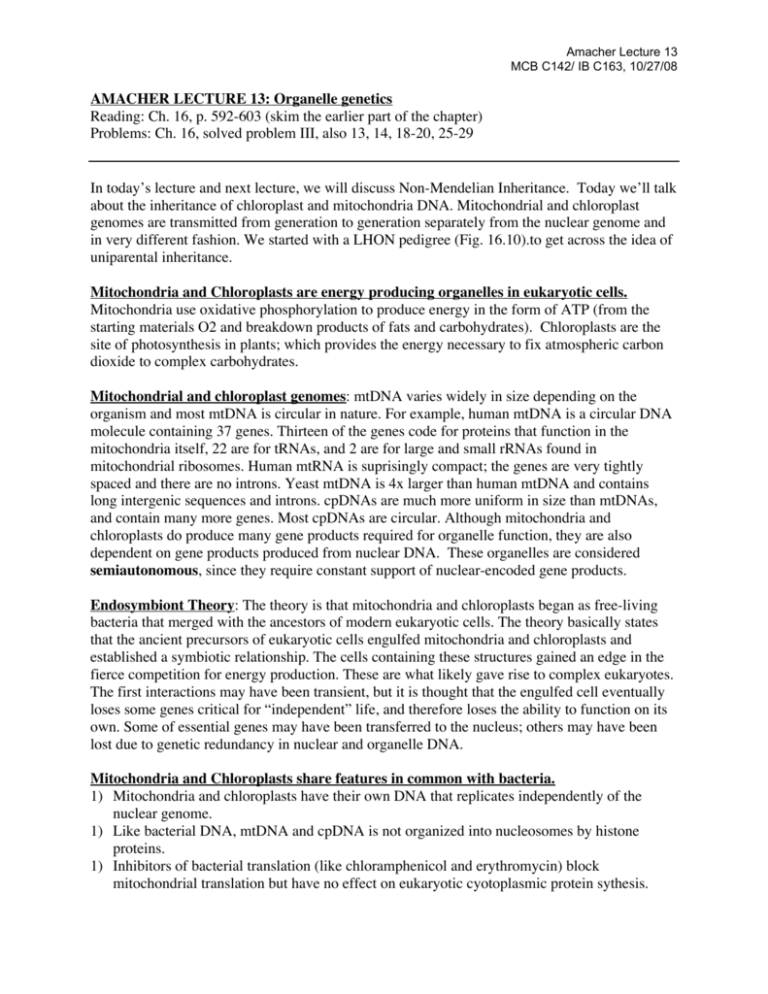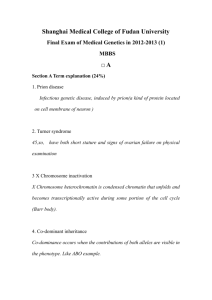AMACHER LECTURE 13: Organelle genetics Reading: Ch. 16, p
advertisement

Amacher Lecture 13 MCB C142/ IB C163, 10/27/08 AMACHER LECTURE 13: Organelle genetics Reading: Ch. 16, p. 592-603 (skim the earlier part of the chapter) Problems: Ch. 16, solved problem III, also 13, 14, 18-20, 25-29 In today’s lecture and next lecture, we will discuss Non-Mendelian Inheritance. Today we’ll talk about the inheritance of chloroplast and mitochondria DNA. Mitochondrial and chloroplast genomes are transmitted from generation to generation separately from the nuclear genome and in very different fashion. We started with a LHON pedigree (Fig. 16.10).to get across the idea of uniparental inheritance. Mitochondria and Chloroplasts are energy producing organelles in eukaryotic cells. Mitochondria use oxidative phosphorylation to produce energy in the form of ATP (from the starting materials O2 and breakdown products of fats and carbohydrates). Chloroplasts are the site of photosynthesis in plants; which provides the energy necessary to fix atmospheric carbon dioxide to complex carbohydrates. Mitochondrial and chloroplast genomes: mtDNA varies widely in size depending on the organism and most mtDNA is circular in nature. For example, human mtDNA is a circular DNA molecule containing 37 genes. Thirteen of the genes code for proteins that function in the mitochondria itself, 22 are for tRNAs, and 2 are for large and small rRNAs found in mitochondrial ribosomes. Human mtRNA is suprisingly compact; the genes are very tightly spaced and there are no introns. Yeast mtDNA is 4x larger than human mtDNA and contains long intergenic sequences and introns. cpDNAs are much more uniform in size than mtDNAs, and contain many more genes. Most cpDNAs are circular. Although mitochondria and chloroplasts do produce many gene products required for organelle function, they are also dependent on gene products produced from nuclear DNA. These organelles are considered semiautonomous, since they require constant support of nuclear-encoded gene products. Endosymbiont Theory: The theory is that mitochondria and chloroplasts began as free-living bacteria that merged with the ancestors of modern eukaryotic cells. The theory basically states that the ancient precursors of eukaryotic cells engulfed mitochondria and chloroplasts and established a symbiotic relationship. The cells containing these structures gained an edge in the fierce competition for energy production. These are what likely gave rise to complex eukaryotes. The first interactions may have been transient, but it is thought that the engulfed cell eventually loses some genes critical for “independent” life, and therefore loses the ability to function on its own. Some of essential genes may have been transferred to the nucleus; others may have been lost due to genetic redundancy in nuclear and organelle DNA. Mitochondria and Chloroplasts share features in common with bacteria. 1) Mitochondria and chloroplasts have their own DNA that replicates independently of the nuclear genome. 1) Like bacterial DNA, mtDNA and cpDNA is not organized into nucleosomes by histone proteins. 1) Inhibitors of bacterial translation (like chloramphenicol and erythromycin) block mitochondrial translation but have no effect on eukaryotic cyotoplasmic protein sythesis. Amacher Lecture 13 MCB C142/ IB C163, 10/27/08 Mitochondrial mutations in Four-o’clock plants: Shortly after Mendel’s work was rediscovered, plant geneticists reported that a certain type of color variegation in four-o’clock plants did not obey Mendel’s law. When they crossed variegated female plants with green male plants, they got variegated offspring (we talked about the fact that they could also get green offspring – below I describe an experiment that more clearly shows maternal inheritance) and when they crossed green female plants with variegated male plants, they got uniformly green offspring. They reported that the variegation trait was inherited from the mother. In most species, organelle DNA is inherited uniparentally, most often materally - Maternal inheritance of Xenopus mtDNA. Wild-type differences in mtDNA from two related species of frog, Xenopus laevis and Xenopus borealis, allow one to distinguish the mtDNA of one species from the other. When X. laevis females are mated to X. borealis males, the F1 progeny have only the X. laevis sequences. When the reciprocal cross is done, again, it is the maternal mtDNA (in this case, X. borealis) that is inherited in the F1 progeny. Many other vertebrates show this type of maternal inheritance of their mtDNA (often explained by the differences in gamete size). - Maternal inheritance of variegation in four-o’clocks. One strain has shoots that are mostly variegated, with some shoots that are fully green or fully yellow-white. Seeds from white shoots give only white progeny (that do not live long), seeds from green shoots give only green progeny, and individual seeds from variegated shoots can given rise to all three types (regardless of pollen source). White shoots have abnormal chloroplasts (leukoplasts) that lack chlorophyll and cannot carry out photosynthesis. - LHON (Leber’s hereditary optic neuropathy, OMIM 535000) disease in humans passes only from mother to offspring. The mutation that causes LHON disease is a change in NADH dehydrogenase (or a number of other enzymes), which effects the efficiency of electron transport and diminishes the cell’s ability to produce enough ATP for cell function and survival. Optic nerve cells are particularly susceptible. Why is there variable inheritance of the disease (not all siblings show signs of the disease, and not all siblings with LHON have the same severity of symptoms)? Terms: We can’t use “heterozygous” and “homozygous” when talking about organelle DNA, since every cell can have many organelles. Instead we use: Heteroplasmic: cells containing a mixture of organelle genomes. Homoplasmic: cells containing only one type of organelle DNA. The optic nerve cells of most people affected by LHON are homoplasmic for the disease mutation. The severity of the phenotype depends upon the random partitioning of organelles into daughter cells during mitosis. The proportion of organelles containing the disease gene can vary in female ova, as well as in somatic cells during embryonic development. Mitotic Segregation produces an uneven distribution of organelle genes in heteroplasmic cells. This can help explain why identical twins from a mother affected by a mitochondrial disease can display different severity of phenotype. Amacher Lecture 13 MCB C142/ IB C163, 10/27/08 The proportion of mitochondrial types in an individual depends on several things, including: (1) the initial distribution of mutant vs. wildtype mitochondria that the mother distributes to her eggs, (2) random mitotic segregation of organelles, and (3) random replication of mtDNA molecules, which can cause some to be disproportionately “amplified” relative to others. Uniparental inheritance of chloroplasts. Chloroplast-encoded genes in Chlamydomonas (a unicellular alga) are inherited uniparentally (not “maternally”, as there are no distinct male and female gametes, just two different cell mating types as in yeast. The zygote is formed by fusion of two equally-sized cells of opposite mating type. Chlamydomonas has one large chloroplast per haploid cell. (The mt gene in the crosses below indicated the mating type, + or -) (We only did one of the crosses below in class, but I include them both for clarity in the notes) Cross: mt+ y1+ sm-r x mt- y1- sm-s, then sporulate the diploid. Progeny: (y1+ sm-r), (y1+ sm-r), (y1- sm-r), (y1- sm-r) The y1 allele is inherited 2:2 in the resulting haploid gametes after sporulation of the diploid, but the sm gene is inherited 4:0 (in 95% of the cases), and reflect the allele present in the mt+ strain. The abnormal segregation is not caused by some peculiar feature of the sm-r gene, because reciprocal crosses show the same outcome of 4:0 segregation. Cross: mt+ y1+ sm-s x mt- y1- sm-r, then sporulate the diploid Progeny: (y1+ sm-s), (y1+ sm-s), (y1- sm-s), (y1- sm-s) The 4:0 ratio of the sm gene indicates uniparental inheritance from the mt+ parent. The cpDNA from the mt- parent is actually degraded in the zygote. Mitochondrial DNA is also inherited uniparentally in Chlamodomonas, but in this case it is the mtDNA from the mt+ parent that is degraded. Biparental inheritance does occur, but is much less frequent. Some examples are in yeast and evening primrose. In yeast, we expect biparental inheritance, because both yeast mating types contribute cytoplasm to the progeny. Figure 16-15 in your book shows a typical example of the mitochondrial inheritance pattern in yeast. Cross: MATa Cr x MATalpha Cs Diploid: a/alpha Cr Cs The diploid is now grown vegetatively and plated out, and colonies are formed from individual cells. If these colonies are now replica-plated on chloramphenicol-containing plates, about half the colonies are Cr and half are Cs. This indicates that both parents must have passed on mitochondria to the progeny, thus inheritance is biparental. However, it also shows that cytoplasmic segregation (each growing yeast bud inherits only a few mitochondria) during mitosis of the diploid heteroplasmon leads to the production of cells that carry only one type of mitochondria. Thus, there is uniparental inheritance at the level of individual cells. Amacher Lecture 13 MCB C142/ IB C163, 10/27/08 How can one tell if a human disease is mitochondrial? (Especially since the phenotypes of affected individuals can be variable.) (1) Inheritance should be consistent with maternal inheritance. (Family members inherit the disease from their mothers and none of the offspring of affected males have the disease). There is a pedigree in Figures 16-10 and 16-14 of your book. (2) Affected tissues should display deficiencies in mitochondrial function (see Figure 16-15), with tissues with high energy requirements (like brain and heart) affected at lower ratios of mutant: wildtype mtDNAs than those tissues with lower energy requirements (like skin). (3) The mitochondria from a patient with a suspected disease can be placed into cells that lack mitochondria and the resulting cytoplasmic hybrid (“cybrid”) can be tested for mitochondrial function. Myoclonic epilepsy and ragged red fiber disease (MERRF; OMIM 545000) is a rare inherited condition caused by a mutation in a mitochondrial tRNA. This mutation affects the synthesis of proteins involved in electron transport and ultimately, the production of ATP. Most tissues in MERRF patients are heteroplasmic for the tRNA mutations, with the muscle and nerve tissues being affected most by the presence of even small numbers of mutant tRNAs. We did not cover MERRF in class, but the discussion in the book is a comprehensive example and you should look at it. SUMMARY OF ORGANELLE INHERITANCE: (1) There is a usually a 4:0 segregation of parental alleles instead of the typical 2:2 pattern seen for nuclear genes. (2) In most organisms, inheritance is thus uniparental, meaning that transmission of mtDNA or cpDNA comes from one parent. But in some organisms, like yeast, mitochondrial inheritance is biparental. (3) When heteroplasmic parents transmit organelles of more than one genotype, mitotic segregation of those genotypes occur in offspring. This is the consequence of random partitioning of organelles during cell division. The severity of the disease symptoms correlates approximately with the proportion of defective organelles, but also depends upon the energy requirements of the tissue. Based on Figure 16-15 in your book: % mutant Brain Heart Skeletal muscle Skin mitochondria 20% affected N.A. N.A. N.A 40% affected affected N.A. N.A. 60% affected affected affected N.A. 80% affected affected (N.A. = not affected) affected N.A or affected






